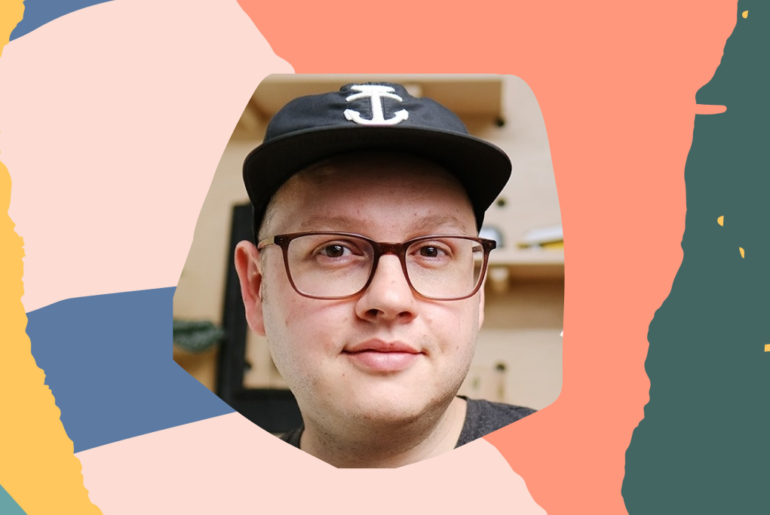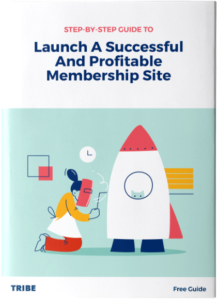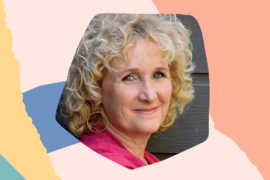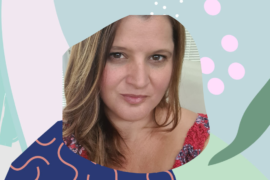In college, artist Justin DeMers had an “aha” moment that unlocked his creativity. That breakthrough allowed him to help large networks, companies, and brands find the extraordinary in the ordinary and produce powerful human interest videos.
Now, at Live Lab, Justin helps entrepreneurs cut through the noise, eliminate distractions, and create powerful live videos to empower their brands and forge meaningful connections. Within that membership is a smaller membership, called Seen and Heard, where he helps people in all industries leverage what he calls “relatable video” throughout their entire business.
Today, Justin joins the podcast to share how he finds the human factor underneath brands, why you can’t automate connection, and how his two-tier membership system uniquely serves both him and his audience.
Key Takeaways
- How a negative critique of Justin’s art led to the “aha” moment that changed his life and career forever.
- Why people need stories to make authentic connections.
- The difference between what you say and what you communicate – and how effective video uses this to move viewers.
- Why Justin created two different membership businesses to best serve his audience.
- How Justin optimizes his memberships for results and nothing else.
Free Give
FREE Guide – Launch & Grow a Profitable Membership Site
Ready to reclaim your time and attract more monthly paying customers? Our step-by-step guide will show you how to build a membership site that turns your passion into recurring profit. Click here to download!
Memorable Quote
“I’m not in this to make more money, I’m in this to help and serve.” – Justin DeMers
Episode Resources
Transcript
Read The Transcript[Introduction]
Stu: There is a big trend brewing that’s revolutionizing the way business is being done. Big companies like Netflix, Amazon and Apple are jumping on this too, but so are thousands of others in all kinds of markets like photography, calligraphy, fitness, finance, meal planning, lesson planning, dog training and so many more. They’re doing it by shifting to a recurring revenue model.
Hi. My name is Stu McLaren. For more than a decade I’ve been helping tens of thousands of entrepreneurs generate recurring revenue through membership sites. Join our host, Shelli Varela, as she takes you behind the scenes to see how these companies are building a thriving tribe that spends with them every single month. Now, let’s get to today’s episode.
[Interview]
Shelli: Justin DeMers, welcome to the It’s a TRIBE Thing Podcast, buddy. I am super stoked to have you.
Justin: Lost for words. I’m actually really, really excited to be here too. This is something I’m really passionate about, both It’s a TRIBE Thing, sharing stories, and then also memberships in general because I’m a fan.
Shelli: I’m a fan of all of those things. Also, especially in our pre-chat just before we got started, we could have talked for a couple of hours just about filmmaking and storytelling. How you have the ability to elicit emotion in people and how that can actually catapult your business. With that said, we’re going to talk about your membership site and how you help people do that very thing. If you would be so gracious to start with your story back before you were so freaking cool, and who were you that ended up being the person that led you to who you are and what you do now.
Justin: Wait, does that mean that I’m not cool anymore? Was this-?
Shelli: No, you’re especially cool.
Justin: I’m just kidding. I’m one of those kids that went to college for a specific thing, and that was all around art. My background is design and photography and a minor in film. I was always interested in just being creative. I have a funny story from Photo 201 where there was this shift that unlocked in my brain around this idea of what art being creative could actually mean. It was this professor; her name was Louise. We do these long form projects in college, and so you’d spend months and months and months creating these projects. At the end, you’d put up your photos and the professor would critique you and the students would critique you.
I remember this one project I was so proud of. I had worked so hard on it and it looked so, so beautiful. The photos were crisp and sharp— this was back in the film day— and the prints were just like, ah. I put them all up and I was excited, beaming and she just hated it. Absolutely hated it. At first, I was just devastated and frustrated, but the way that she spoke about why she didn’t like it was that, yeah, it’s pretty but it didn’t have any meaning. It was surface level. Attractive without meaning in the art world, there’s no place for that. Whereas you can have something really unattractive but if it has a really deep meaning, well, that can still affect people in a really positive or interesting way.
Shelli: Was that an aha moment for you? Or did you disagree with her in-?
Justin: 100%. It literally changed the trajectory of my life. From that point on, it was all around this idea of asking why and understanding that there has to be something deeper or it’s not going to hold your attention or your viewers’ attention. I kept going down the photo and ultimately into the world of filmmaking with this idea that it can’t just be about surface.
That led me to wedding films that were no longer focused on the stuff of a wedding day, like here’s the bride and groom, or the groom and groom, or bride and bride, or flowers. Whatever. It doesn’t matter. It’s why are these people getting married? Why do they love each other? Why does that mean so much? Why does this bouquet matter? It just became this fascination.
That led us to tremendous experiences for shooting large companies, large networks, large brands, working on largely human based stories. Showing the world that in a lot of cases, really, “ordinary” people are quite extraordinary. That’s what I do now in a different capacity by just helping entrepreneurs understand that at a deep core level, we can connect so deeply with video. It doesn’t mean they’ve got to be fancy. It doesn’t mean they’ve got to look polished. It doesn’t mean they’ve got to look pro. There just has to be that human connection element to it. When you have that in your videos, it’s an amazing tool whether it’s for marketing, sales, retention, all that kind of stuff.
Shelli: When you were talking… Whatever you’re willing to share, obviously, but do you have any examples that you can share of, say, a company that you worked for and then the human element… like the shift in creating that human story? For many of the people that are either in TRIBE or listening to this podcast right now who don’t belong to TRIBE, one of the things that I hear them say often is, “Well, I’m not a personal brand. I sell a product.” You’ve worked with many companies who sell a product. What can you share with the listeners about how the product actually has a soul if you show them the meaning of the story behind the story?
Justin: We were doing a story for a Super Bowl Open. This was for CBS. You look at the ball that’s used the Super Bowl at the football, that’s made by someone. That’s not a robot that makes that. It’s literally hand-sewn for the Super Bowl. One of the stories we did was on the woman who has sewn every single football leading up until her retirement. Literally, since the beginning of the Super Bowl until when we filmed the story, she has sewn every single football used in the Super Bowl. That level of commitment and dedication and just craftsmanship goes unnoticed until someone shines a spotlight on it and says like, “This little tiny fraction of the Super Bowl, this giant, huge event, that’s just one thing. There’s a lot that goes behind the scenes in the Super Bowl that’s all affected by humans. It’s like a show put on by individuals that come together to put the spectacle and experience on for all of us.”
That’s the kind of story that we were fascinated and interested by is just this idea of, again, a regular person. She just looks like a regular person but here she is, she’s got this amazing story and she can recount every single Super Bowl. She watches them. Tremendous power in that little story; this idea of dedication to your craft and devoting your life to something that isn’t a quick fix or isn’t a flash in the pan, but really caring about what you do and being proud of it and having craftsmanship.
Those are the types of stories that we did for big companies. We would just go in. We were really good at story research and finding great stories within regular people. We had a blast, an absolute blast just making people feel really special in the process. Just letting them know that what they do matters.
Shelli: That so translates to anybody who has a business, right, and for what you do and how you help. It’s interesting to me and always been fascinating about how you have the ability to guide the audience’s attention. To your point, that one person who stitched all of those Super Bowls is like a thread through history, through time. When you think about that, just have the ability to shine the light on that one specific detail, when we do that in our businesses and when you help people with the craft of allowing that deep connection, which is the reason that people say yes to your offer and yes to the transformation that it creates.
It’s not as simple as… On the outside, it would be easy to say you help people do compelling videos that help them make sales. What you actually do is allow them to feel seen and heard— and we’ll get into the title of your membership site, which is genius. You allow the business owner to feel seen and heard. What that does is it allows the potential audience to become clients because they’re saying yes because of a compelling video, because they say, “Yes, I’m with that person. That has to be my person.”
Justin: Yeah. I learned really quickly in business it’s all about connection. You can’t automate that. As much as we want to use all the tools and the software and we love it, at the end of the day, people buy from people. As soon as you can build a real connection with someone, they’re far more likely to say, “Hey, you can help me.” Or, “Hey, I belong to this group.” Or, “Hey, I want to be here with you.” I’m biased because I’m the video guy, but video has such a tremendous power to cut through a lot of filters or guards that people have and just pierce someone’s heart. That’s the same reaction you get when you watch a documentary and you’re just visceral. You have something in your body and you’re like, “Ah.” That is the power of video.
Shelli: It’s the gift of making people feel. A great example of that, I remember when the movie Titanic came out. Before anybody had actually seen it, there was this incredible movie and the budget was over the top and people are like, “Why would you go see the Titanic? We all know how it ends.” Then it became this blockbuster thing because the Titanic and the sinking of the Titanic was the backstory for Rose and Jack. It’s like, oh, that is the stuff of transformation for people. What that’s-
Justin: When you look at that story, it’s also the story of the pianists playing the piano while the ship is going down. Those are other human elements that they’ve added to this where, yeah, it’s so good.
Shelli: And so many small nuances that make you feel a certain way. To your point, when you watch the imagery that they’ve chosen to shoot for that specifically, and you have this guy and he’s like, “No, I’m going to play it out.” It’s just that feeling of loyalty, and dedication, and service to others, and making other people’s lives better. You can do that in an image or in a small, quick narrative. This is what you’re genius at doing. With that said, would you share with us how you segued into membership sites and courses and what that looks like for your business, but also how you help the people on the other end of your membership site.
Justin: I’m new to the online world, per se, in that I’ve only been exposed to Stu, for example, for a couple of years. It’s partly because I kind of had my head down. Our company was making films and traveling the world. Yeah, we were teaching and we were sharing what we knew but at the end of the day, our main business was servicing clients. Big budgets, big projects and we didn’t have time for a lot of other stuff.
When I got exposed to this online world, I realized pretty quickly that, one, there’s a lot of misinformation around video. It’s not to anybody’s fault. It’s just not accurate in a lot of cases. Two, people make things really complicated, unnecessarily complicated to the point where they don’t do it. What I do inside of Click Go Live and Live Lab and Seen and Heard is in one sense, I cut through the noise and say, “This is what works, and only this.” I also make sure that people are not getting in too deep into things like cameras and lights and lenses and audio to the point where it’s actually hindering them to connect with their audience.
One of the things that I talk about and I walk my members through is this idea of in video there’s what you say, so the words, but there’s also what you communicate. That whole component of what you communicate is why when you go to a horror film, your hair stands up and you get scared. No one is telling you to be scared. You just are. That is the power of video. We can do that with our phones. We don’t need big budgets to be able to get people to feel a certain way.
In a lot of cases, people think they need better production value, they need better quality everything. What that actually does in a lot of cases, unfortunately, is diminishes that connection point. One of the examples I always share is this idea of like, if you go watch a documentary and it looks too good, you don’t believe it. Documentaries look a certain way because they’re more believable. If I were to go shoot a documentary and have beautiful lighting and multiple camera angles and crystal clear audio, and I said, “This is a documentary,” I would have a lot of people that would be like, “How much of that is real?” It’s like reality TV at that point. They can make documentaries look good, but they don’t.
There’s a little bit of like magic to that that every online entrepreneur can leverage, which is this idea of “I don’t need to worry so much about being perfect. I just need to worry about connecting.” That’s what I do at the very root of what I teach. I have different things that people can do but at the end of the day, it’s all about connection. As soon as you connect, your business grows.
[Interview break]
Stu: So many people in all kinds of niche markets are leveraging their existing knowledge and influence, and they’re transforming it into passive monthly income. This isn’t luck. This is a repeatable formula for producing a growing subscription income. If thousands of others can do it, you can too. To find out what type of membership site would be right for your business, visit www.gettribeguide.com. Go to www.gettribeguide.com and download it today. You’re awesome!
[Interview resumes]
Shelli: That’s really genius and fresh and insightful. I wanted to offer you this as you were talking, I’m like, “That’s interesting.” You said you were new to the online space when you watched people and how complicated it was, and a lot of people weren’t starting. The thing that came to me right away was, a lot of the people who are not starting have been in the online space for a long time. Everybody has a formula or a five step this or…
What I love that you bring, that you offer is you haven’t been in the online space for a long time, so you come with a completely new set of fresh eyes. It’s like, “Hey, have you thought about doing it this way?” Because you have not been indoctrinated with the “These are the seven steps of what you have to do.” What happens, it becomes very systematic and templated, which is the opposite of what people need to do. The irony is if you just tap into that human element, it can be so much actually easier than having to be formulaic.
Justin: Yeah. That’s kind of the secret of our success is this idea of being really crystal clear on why we’re doing things and making really intentional decisions. I don’t have a step by step “Do this, do this, do this, do this,” for building a business. It’s like, “What matters to you in life?” This is kind of an aside but, “What matters to you in life and how do you optimize for that?” When you look at it like that, you show up different.
When I go live, one of the things that I do— and I walk my members through this— is this idea of I don’t ever feel like I have to go live. I always feel like I get to go live. In my business, if I ever feel like I have to do something, something is wrong. That is not how I want to set my life up. That also carried through into this online world where if something didn’t feel right to me, even if it could, again, “make more money”, if it didn’t align with who I am as a person, I don’t do it. It doesn’t matter. I’m not in this to make more money. I’m in this to help and serve. Yeah, it’s a business and I make money, but if I’m optimizing for making more money, usually that comes at a cost to the people.
Shelli: Yeah. It also comes at a cost to your own congruency and what’s true for you. I love that you said that too, you don’t have to go live, you get to go live. What I’ve noticed a lot is when people are all up in their heads about what they have to do, it feels like a job. It can be so much simpler. I was going to say more simpler.
Justin: You make yourself a job. You’re like, “I’m going to be an entrepreneur.” Then you end up just giving yourself a job. You know what I mean?
Shelli: Yeah, and you’re like, “This is [crosstalk 00:15:38]. I immediately regret this decision.” Yeah. To your point, it can be so much simpler if you just ask yourself some really root questions about your values, who you are and what you want to create and how you want to show up for your people. For you, you’ve created two membership sites. Can you walk us through that a little bit of who you help and how you help them at each different stage?
Justin: Yeah. The way that my funnel works, I suppose, is I have a really simple online workshop. It’s about two hours. It’s called Click Go Live. It just walks people through a simple framework for going live to do two things: One, go live confidently. Then the second part is a simple formula to follow so that you don’t get freaked out about fumbling or making mistakes or saying the wrong thing or… I work from my home. I’ve got two kids. They hop in my lives. None of that phases me, and I want people to have that level of confidence.
That’s kind of how people enter our world, our ecosystem, if you will. Then once they have that, they get introduced to our memberships. Our lower-priced membership is called Live Lab. It’s basically me and a group of nearly 200 people, helping them implement what I cover in the workshop. So often we buy things and we have all the greatest intentions of the world, and then we hit a stumbling block and we can’t move forward because there’s no one there to remove that for us.
I know that in a lot of cases for business owners, the simplest path to connection is live video. It’s immediate. There’s no filter. You and I, we’re live now and this is powerful. We have this gift in Facebook, in Instagram, in YouTube, now in LinkedIn. I recognize, though, that it’s also kind of scary. Live Lab is me helping remove those blocks to make sure that they are going live. Any questions that they have, if they’re worried about their setups or gear, that kind of stuff.
That’s the very first step in my overarching success path, if you will, is this idea of you conquer live video. Once you conquer that there’s this whole other world of possibility with video. Whether that’s testimonials, whether that’s ads, whether that’s webinars, you name it. I have a much higher priced membership on the backend of Live Lab that’s called the Seen and Heard collective. It’s a much smaller group. There, I’m helping entrepreneurs of all industries leverage video— I call it relatable video, human video— leverage human video throughout their entire business.
Shelli: I loved the Seen and Heard tagline because I find myself saying that a lot as well. If I may be so bold to say what that means for me and with the people’s that I work with story as well, oftentimes as entrepreneurs we feel like we’re knocking on locked doors or screaming in deaf ears. We don’t understand because it’s like we’re doing all of the things that we were told we should do and that I’ve witnessed other people get results from. What happens is when that entrepreneur doesn’t feel seen and doesn’t feel heard, it creates a certain kind of inner story about fear that we don’t often give a voice to, which is, “Am I actually good enough?” When it sometimes is as simple as you just needed to do it in a different way so people can hear you in a different way, so people can see you in a different way, and ultimately, people can connect to you in a different way.
Justin: It’s interesting. The story behind Seen and Heard in a lot of cases is as much about your audiences feeling seen and heard as it is about you being seen and heard. This frustrates me, but there’s a lot of people that go on through their daily lives that aren’t really recognized. They’re not made to feel special. They’re not seen or heard. They just do their thing.
When you’re a coach or a course creator or a membership site owner, your members are feeling seen and heard. They’re with you for life because you’re going out of your way to make them feel special in a world where very few people do that. That goes back to the whole concept of connection and relatable video content. It’s the backbone of what I do, is if you go out of your way on your live streams, for example, to make sure that every single person that gives you time of day, to make sure that you let them know that you’re grateful for that, it’s an immediate lifelong fan creator.
There’s ways you can do that that are really simple. One of the things I do is I send video DMs to anyone that comes into my world that engages with my content. I go out of my way. I do walks twice a day and I just send 20 or 30 video DMs to people and just say, “Hey, I appreciate you checking out this.” Or, “Hey, I appreciate that you’re here.” Or, “Hey, I’m just grateful that you checked out my live video.” Small little things, but the amount of responses I get from people that are like, “Dude, I’ve watched live videos for five years and not a single person has ever thanked me for watching their video.” Such a small thing but, again, they feel seen and heard because they are. I appreciate them watching my live video, for example.
Shelli: If you were to give advice to somebody who’s listening right now and thinking they potentially want to start their own membership site, what advice would you give them? What’s the best piece of feedback that you have received from one of your members as a result of you saying, “Yes, I’m going to do a membership site”?
Justin: The piece that fits so well with what I’m doing is that the membership is implementation based. I don’t teach anymore on the membership. There’s nothing in there where I’m like, “Hey, you need to learn this new thing.” It’s literally, “You got the thing. Now let me help you implement it.” That content treadmill that Stu talks about is real. If you set that membership site with this idea of constantly having to do more and more and more content, you’re in for a rough ride.
When I look at my membership, the things that I’m optimizing for are results. I don’t care about anything else. Actually, the last month I removed something. I legitimately was like, “This is not leading to more results so I’m going to take this out.” The tip I would share is always be looking at, are your members getting the thing that they want? If not, is something getting in their way or is something not there that should be there?
Shelli: Genius. What is the best bit of feedback that you’ve received as a result of saying yes to starting yours?
Justin: My Facebook feed now is just full of amazing live videos. It’s people that have gone through Click Go Live and are in Live Lab now. I think the feedback that I’ve gotten is this idea of it’s okay not to be perfect. It’s okay not to look like you’ve got makeup and your hair done every single time, or that you sound so smart, or that you’ve got the perfect script. Finally, someone has given me that permission. I think, in some capacity, I give people permission to just be them. So often we see these influencers that look perfect and whatever, and we think we have to be that.
Yeah. I guess the feedback that I’ve gotten is around that idea of just being thankful that there’s this safe space on the internet where you can be you. You can go live however you want looking and feeling really confident and that you’re connecting with your audience.
Shelli: 30 days, a couple of years ago, I did these things and I call them brain jams. Every day I would go live for 60-90 seconds only, just a micro topic. I made a promise to myself that I was going to do it every single day. There were a couple of days where I was just like, “Man, I don’t want to. The lighting is bad. I look terrible,” all of the list of things, but I made myself a promise. I remember one day, it was probably 11 o’clock at night. I had forgotten to go live and I thought, “Well, I’m just going to do something real quick.” I’d been having a conversation with a good friend of mine and she was talking about how lonely she was. I riffed on loneliness for like 60 seconds and my feed blew up. I was in my bedroom. I think I might’ve been in my pajamas actually, and I was just doing it because I was honoring a promise to myself.
To your point, there were other videos that I recorded that I actually put a lot of time and thought into. They were still only 60 to 90 seconds but in my mind, they were like mini art. They were profound and the lighting was great and I looked awesome. They didn’t even touch the one where I was sitting at the end of my bed, in my pajamas, with my hair in a Cindy Lou Who ponytail and I riffed on loneliness for 60 seconds so-
Justin: That goes back to my college days. You can have the perfect art but if there’s nothing behind it, people aren’t going to care.
Shelli: Well, thank you for teaching people the skills that you teach them and teaching them how to be unapologetically themselves, because the world definitely needs more of that. I’m grateful for you. I’m hoping to talk to you a whole bunch more because I think you’re a genius. Super grateful that you took the time to come. Thanks so much.
Justin: I appreciate you. I’m excited to keep the conversation going.
[Conclusion]
Stu: I hope you loved that story. It’s amazing, right? That’s what It’s a TRIBE Thing is all about. So many people in all kinds of niche markets are leveraging their existing knowledge and influence, and they’re transforming it into passive monthly income. Listen, this isn’t luck. There’s a repeatable formula for producing a growing subscription income. Each week we’re going behind the scenes to show you exactly how they did it. Get the latest stories and actionable ideas from each episode at www.itsatribething.com. If you know one other person who could benefit from this, tell them to subscribe. Tell them to go to www.itsatribething.com.
END OF SESSION
To learn more and get access to all episodes, visit our podcast page!






